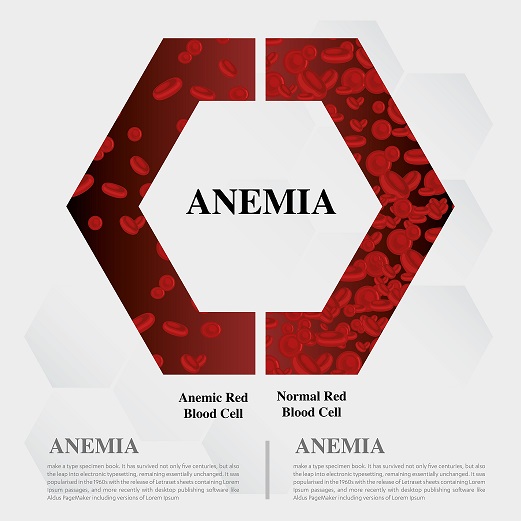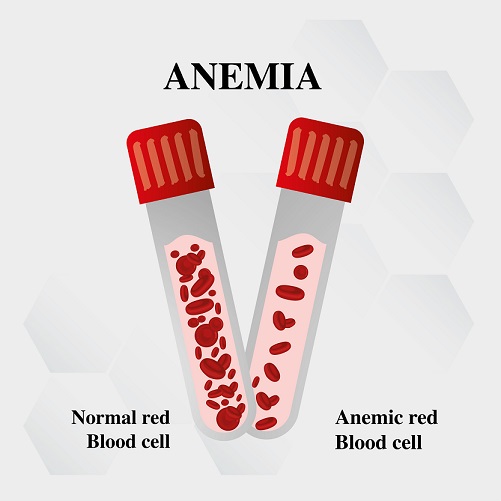Anemia is a blood condition characterized by reduced circulating red blood cells with a reduced quantity of hemoglobin. It can be classified pathologically based on anemia due to blood loss, impaired cell formation and increased cell destruction. Nurses’ role is management of anemia includes assessment of the patient’s condition and coming up with appropriate nursing diagnosis. They then plan for the care to provide guided with scientific rationale.
Some of the nursing diagnoses for anemia include impaired gaseous exchange, ineffective tissue perfusion, fatigue, deficient knowledge and risk of infection as discussed below together with the desires outcomes and interventions:

Read our popular article " What is the nursing diagnosis for pneumonia"
Nursing Diagnosis
Impaired gaseous exchange related to decreased oxygen-carrying capacity secondary to reduced red blood cell life span as evidenced by dyspnea, respiratory rate of 10, diaphragmatic breathing, tachycardia, and lethargy
Desired Outcome
Anemia Patient to demonstrate improved oxygenation evidenced by respiratory rates within 12 to 20 breaths per minute and absence of cyanosis and labored breath within 24hrs
Should be able to perform activities of daily life without demonstrating intense lethargy after 48hrs.
Patient to display normal ranges of pulmonary function tests by the end of hospital stay.
Nursing Intervention and Rationale

Monitor the vital signs every 4 hours. Respiratory rate, blood pressure levels, heart rate and temperature is taken initially to act as baseline data from which reference can be made. Normal respiration rate is between 12 to 20 breaths per minute. Normal heart rate is 60 to 100 beats per minute. Severity of the impaired oxygenation is gauged from the baseline and thus necessary interventions can be initiated thereafter.
Assess the patient’s level of consciousness 2 hourly using the AVPU scale. The level of awareness reflects on the level oxygenation to the brain tissues. Respiratory centers are located in
The brain and thus should be stimulated accordingly. The brain tissue is sensitive to hypoxia and with reduced levels blood is only shunted to vital organs only. An early identification of reduced level of consciousness can be an indication of a developing hypoxia and thus countered appropriately.
Position the patient in semi-fowler’s position. Adjust the patient’s bed to 45°. The positioning is to promote adequate lung expansion to ensure efficient amounts of oxygen in the lungs during inspiration. This promotes ventilation thus boosts level of oxygen in blood.
Teach the patient deep breathing exercises. The patient is taught how to perform the deep breathing exercises to enhance adequate lung expansion. When lung expansion is enhanced oxygenation in the tissues is promoted.
Administer oxygen therapy via face mask at a rate of 10 liters per minute. The rationale is to promote the ventilation perfusion quotient and thus maximum gaseous exchange is enhanced.

Nursing Diagnosis
Ineffective tissue perfusion related to decreased hemoglobin levels as evidenced by cyanosis, palpitations, pale conjunctiva, capillary refill of 5 seconds, Hemoglobin count less than 69
Desired Outcome
Patient to demonstrate adequate tissue perfusion evidenced by capillary refill less than 2 seconds, stabilized vital signs (HR) after 12hrs.
Nursing Interventions and Rationale
Monitor vital signs every 4 hours. The RR, HR, T and BP are taken to have baseline data from which progress can be gauged.
Monitor hemoglobin, hematocrit and red blood cells levels. Complete blood count is taken. This provides a baseline blood profile. It also indicates deviations from which necessary interventions can be taken. For instance, lower Hb levels necessitate activation of blood transfusion protocol.
Administer intravenous fluids as prescribed by the physician. The fluids maintain adequate circulation volume. This enhanced circulation promotes tissue perfusion. Continuous assessment should be done in order to avoid blood hemodilution.
Administer supplemental oxygen as prescribed. Oxygen therapy promotes perfusion in the lungs usually reflected by increases blood saturation levels.
Administer blood component therapy as ordered. This boosts Hb levels and thus enhances perfusion. Correct protocol should be used when blood is administered to avoid adverse effects. Continuous assessment should be done to avoid adverse blood reactions. In case of reactions, the transfusion should be stopped immediately.

Nursing Diagnosis
Fatigue related to decreased oxygen-carrying capacity of blood as evidenced by dyspnea, patient reports exhaustion and reduced physical activity.
Desired Outcome
Patient to report reduced fatigue evidenced by ability to perform self-care activities and activities of daily life after 48 hours.
Nursing Interventions and Rationale
Assess patient’s level of fatigue plus hemoglobin, hematocrit levels and red blood cell counts. This is to rule out hypoxia as the cause of fatigue. Comparison of the laboratory values is used to evaluate the prognosis.
Educate the patient on energy conservation techniques. For example, setting priorities in doing activities and delegation of duties. The rationale is to preserve energy and use of energy on immediate essential activities.
Provide supplemental oxygen therapy. This enhances ventilation perfusion quotient as the oxygen-carrying capacity of red blood cells is enhanced. Adequate oxygen is thus available for respiration. Energy is released in the form of ATP.
Nursing Diagnosis
Deficient knowledge related to unfamiliarity with the diagnosis and the complex treatment regimen as evidenced by patient asking questions about the disease and treatment methods, and fear.
Desired Outcome
Patient to demonstrate a clear understanding of diagnosis by being able to describe the disease and the treatment after 6 hours.

Nursing Intervention and Rationale
Assess the patient’s knowledge on the diagnosis to determine the patient’s conversant levels. It helps the nurse know where to begin from in educating the patient.
Educate the client on the disease, Anemia. The client is also informed on the diagnostic criteria used together with the treatment methods. This not only promotes the patient’s understanding of the disease but also alleviates fear. Understanding is gauged by asking the patient questions.
Educate the family of the diagnosis. Make sure to explain clearly the reason of hospitalization together with nursing care provided. This promotes cooperation of the family in the provision of care.
Nursing Diagnosis
Risk of infection related to bone marrow malfunction.
Desired Outcome
Patient to be infection-free evidenced by absence of signs of infection throughout the hospital stay.
Nursing Interventions and Rationale
Assess for signs of infection in order to act in time. Signs of infection include fever, pain, chills and body malaise. Nosocomial infections are common in aplastic anemia because of the immunosuppression.
Monitor white blood cell count levels. Levels below 4,000 white blood cells per microliter of blood predispose the patient to infection. This thus enables necessary interventions to be initiated in advance.
Teach the patient on effective hand washing procedure. This ensures transfer of micro-organisms causing diseases is inhibited.
Stress the importance of self hygiene plus effective mouth and perineal care. The measures help prevent skin breakdown and minimize risk of infection.
Initiate antibiotic therapy. Ceftriaxone 500mg is administered 8 hourly for 5days. It acts as prophylaxis against any bacterial infections.
Conclusion
Provision of nursing care is supposed to be followed by a clear documentation. What is not documented is assumed to nor be done. Continuous assessment of the patient’s condition is done to adjust the care accordingly. Holistic care is provided and it is individual based. For complications, referrals are prompted.
References
Herdman, T. H., & North American Nursing Diagnosis Association. (2008). NANDA-I nursing diagnoses.
Hinkle, Janice L., and Kerry H. Cheever ( 2018) .Brunner & Suddarth’s Textbook of Medical- Surgical Nursing. Chicago 15th Edition.
